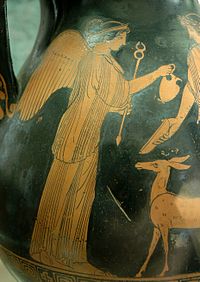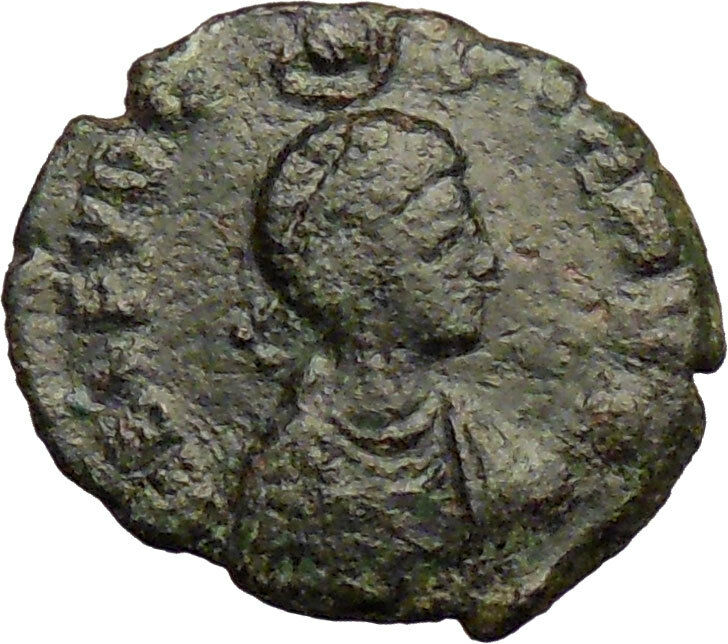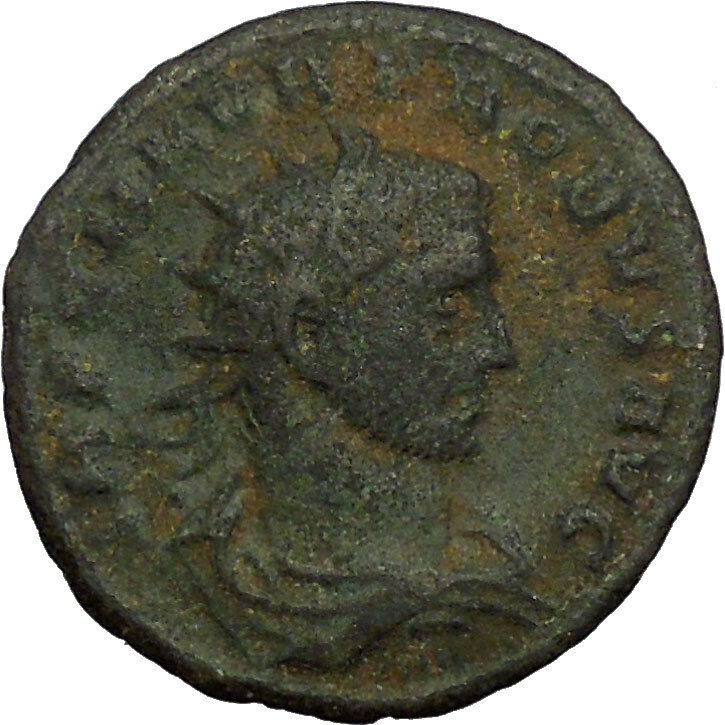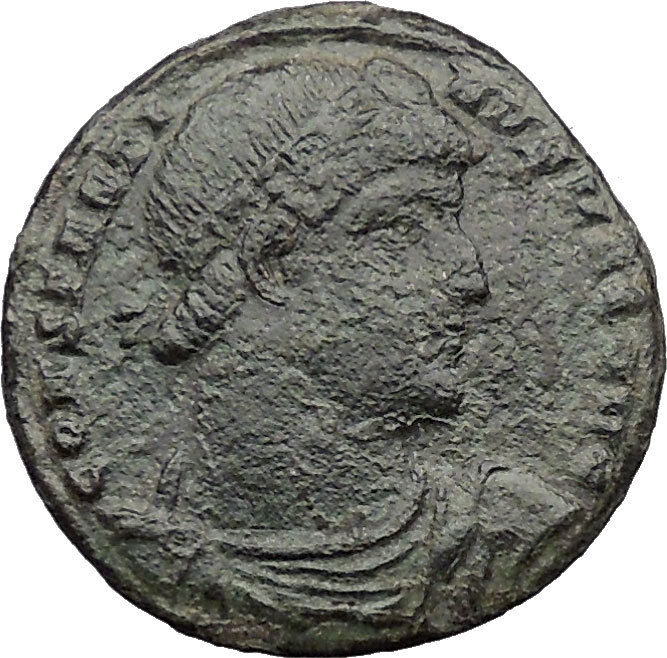|
Augustus – Roman Emperor: 27 B.C. – 14 A.D.
Bronze Quadrans 15mm (3.16 grams) Lamia Silius Annius moneyer, Rome mint: 9
B.C.
Reference: RIC 420; BM 200; Paris 568; C 338
Names of three moneyers LAMIA SILIVS ANNIVS around clasped hands holding
caduceus.
III VIR A A A F F around large S C.
You are bidding on the exact item pictured,
provided with a Certificate of Authenticity and Lifetime Guarantee of
Authenticity.
The caduceus from
Greek
“herald’s staff” is the staff carried by
Hermes
in
Greek mythology
. The same staff was also borne
by heralds in general, for example by
Iris
, the messenger of
Hera. It is a short staff entwined by two
serpents
, sometimes surmounted by wings. In
Roman iconography it was often depicted being carried in the left hand of
Mercury
, the messenger of the gods, guide of
the dead and protector of merchants, shepherds, gamblers, liars, and thieves.
As a symbolic object it represents Hermes (or the Roman Mercury), and by
extension trades, occupations or undertakings associated with the god. In later
Antiquity
the caduceus provided the basis for
the
astrological symbol
representing the
planet Mercury
. Thus, through its use in
astrology
and
alchemy
, it has come to denote the
elemental metal
of the same name.
By extension of its association with Mercury/Hermes, the caduceus is also a
recognized symbol of commerce and negotiation, two realms in which balanced
exchange and reciprocity are recognized as ideals.[4][5]
This association is ancient, and consistent from the Classical period to modern
times. The caduceus is also used as a symbol representing printing, again by
extension of the attributes of Mercury (in this case associated with writing and
eloquence).
The caduceus is sometimes mistakenly used
as a symbol of medicine and/or medical practice
,
especially in
North America
, because of widespread confusion
with the traditional medical symbol, the
rod of Asclepius
, which has only a single snake
and no wings.
The term kerukeion denoted any herald’s staff, not necessarily
associated with Hermes in particular.[7]
Lewis Richard Farnell
(1909) in his study of
the cult of Hermes assumed that the two snakes had simply developed out of
ornaments of the shepherd’s crook used by heralds as their staff.[8]
This view has been rejected by later authors pointing to parallel iconography in
the Ancient Near East. It has been argued that the staff or wand entwined by two
snakes was itself representing a god in the pre-anthropomorphic era. Like the
herm
or
priapus
, it would thus be a predecessor of the
anthropomorphic Hermes of the classical era.
Ancient Near East
William Hayes Ward
(1910) discovered that
symbols similar to the classical caduceus sometimes appeared on
Mesopotamian cylinder seals
. He suggested the
symbol originated some time between 3000 and 4000 BCE, and that it might have
been the source of the Greek caduceus.[10]
A.L. Frothingham incorporated Dr. Ward’s research into his own work, published
in 1916, in which he suggested that the prototype of Hermes was an “Oriental
deity of Babylonian extraction” represented in his earliest form as a snake god.
From this perspective, the caduceus was originally representative of Hermes
himself, in his early form as the Underworld god
Ningishzida
, “messenger” of the “Earth Mother”.[11]
The caduceus is mentioned in passing by
Walter Burkert
[12]
as “really the image of copulating snakes taken over from Ancient Near Eastern
tradition”.
In Egyptian iconography, the
Djed pillar is depicted as containing a snake in a frieze of the
Dendera Temple complex
.
The rod of Moses
and the
brazen serpent
are frequently compared to the
caduceus, especially as Moses is acting as a messenger of God to the
Pharaoh
at the point in the narrative where he
changes his staff into a serpent.[13]
Classical antiquity
Mythology
The
Homeric hymn
to Hermes relates how Hermes
offered his lyre fashioned from a tortoise shell as compensation for the
cattle he stole
from his half brother
Apollo
. Apollo in return gave Hermes the
caduceus as a gesture of friendship.[14]
The association with the serpent thus connects Hermes to
Apollo
, as later the serpent was associated
with Asclepius
, the “son of Apollo”.[15]
The association of Apollo with the serpent is a continuation of the older
Indo-European
dragon
-slayer motif.
Wilhelm Heinrich Roscher
(1913) pointed out
that the serpent as an attribute of both Hermes and Asclepius is a variant of
the “pre-historic semi-chthonic serpent hero known at Delphi as
Python
“, who in classical mythology is slain by
Apollo.[16]
One Greek myth of origin
of the caduceus is part of the
story of Tiresias
,[17]
who found two snakes copulating and killed the female with his staff. Tiresias
was immediately turned into a woman, and so remained until he was able to repeat
the act with the male snake seven years later. This staff later came into the
possession of the god Hermes, along with its transformative powers.
Another myth suggests that Hermes (or Mercury) saw two serpents entwined in
mortal combat. Separating them with his wand he brought about peace between
them, and as a result the wand with two serpents came to be seen as a sign of
peace.[18]
In Rome, Livy
refers to the caduceator who
negotiated peace arrangements under the diplomatic protection of the caduceus he
carried.
Iconography
In some vase paintings ancient depictions of the Greek kerukeion are
somewhat different from the commonly seen modern representation. These
representations feature the two snakes atop the staff (or rod), crossed to
create a circle with the heads of the snakes resembling horns. This old graphic
form, with an additional crossbar to the staff, seems to have provided the basis
for the graphical
sign of Mercury
(☿) used in
Greek astrology
from Late Antiquity.[19]
Use in alchemy
and occultism
As the symbol of both the
planet
and the
metal
named for Mercury, the caduceus became an
important symbol in
alchemy
.
The
crucified serpent
was also revived as an
alchemical symbol for
fixatio
, and
John Donne
(Sermons 10:190) uses
“crucified Serpent” as a title of
Jesus Christ
.
Symbol of commerce
A simplified variant of the caduceus is to be found in dictionaries,
indicating a “commercial term” entirely in keeping with the association of
Hermes with commerce. In this form the staff is often depicted with two winglets
attached and the snakes are omitted (or reduced to a small ring in the middle).[20]
The Customs Service of the former
German Democratic Republic
employed the
caduceus, bringing its implied associations with thresholds, translators, and
commerce, in the service medals they issued their staff.
Misuse as symbol
of medicine
It is relatively common, especially in the United States, to find the
caduceus, with its two snakes and wings, used as a symbol of medicine instead of
the correct rod of Asclepius, with only a single snake. This usage is erroneous,
popularised largely as a result of the adoption of the caduceus as its insignia
by the
US Army medical corps
in 1902 at the insistence
of a single officer (though there are conflicting claims as to whether this was
Capt. Frederick P. Reynolds or Col. John R. van Hoff).[21][22]
The rod of Asclepius is the dominant symbol for professional healthcare
associations in the United States. One survey found that 62% of professional
healthcare associations used the rod of Asclepius as their symbol.[23]
The same survey found that 76% of commercial healthcare organizations used the
Caduceus symbol. The author of the study suggests the difference exists because
professional associations are more likely to have a real understanding of the
two symbols, whereas commercial organizations are more likely to be concerned
with the visual impact a symbol will have in selling their products.
The initial errors leading to its adoption and the continuing confusion it
generates are well known to medical historians. The long-standing and abundantly
attested historical associations of the caduceus with commerce, theft,
deception, and death are considered by many to be inappropriate in a symbol used
by those engaged in the healing arts.[22]
This has occasioned significant criticism of the use of the caduceus in a
medical context.
Augustus
(Latin:
IMPERATOR·CAESAR·DIVI·FILIVS·AVGVSTVS; 23 September 63 BC – 19 August
AD 14
), born Gaius Octavius Thurinus, was
adopted
by
his great-uncle
Julius Caesar
in 44 BC, and between then and 27 BC was officially named
Gaius Julius Caesar Octavianus. After 27 BC, he was named Gaius Julius
Caesar Augustus. Because of the various names he bore, it is common to call
him Octavius when referring to events between 63 and 44 BC, Octavian
(or Octavianus) when referring to events between 44 and 27 BC, and
Augustus when referring to events after 27 BC.

He became the first
emperor
of the
Roman
Empire
, which he ruled alone from 27 BC until his death in AD 14. The young
Octavius came into his inheritance after Caesar’s assassination in 44 BC. In 43
BC, Octavian joined forces with
Mark
Antony
and
Marcus Aemilius Lepidus
in a
military dictatorship
known as the
Second Triumvirate
. As a
triumvir
, Octavian ruled Rome and many of its provinces as an
autocrat
, seizing consular power after the deaths of the consuls
Hirtius
and
Pansa
and having himself perpetually re-elected. The triumvirate was
eventually torn apart under the competing ambitions of its rulers: Lepidus was
driven into exile, and Antony committed suicide following his defeat at the
Battle of Actium
by the fleet of Octavian commanded by
Agrippa
in 31 BC.
After the demise of the Second Triumvirate, Octavian restored
the outward facade of the
Roman Republic
, with governmental power vested in the
Roman
Senate
, but in practice retained his autocratic power. It took several years
to work out the exact framework by which a formally republican state could be
led by a sole ruler; the result became known as the
Roman
Empire
. The emperorship was never an office like the
Roman dictatorship
which Caesar and
Sulla
had held before him; indeed, he declined it when the Roman populace
“entreated him to take on the dictatorship”.
By law, Augustus held a collection of powers granted to him for life by the
Senate, including those of
tribune
of
the plebs and
censor
.
He was consul
until 23 BC.
His substantive power stemmed from financial success and resources gained in
conquest, the building of patronage relationships throughout the Empire, the
loyalty of many military soldiers and veterans, the authority of the many honors
granted by the Senate,
and the respect of the people. Augustus’ control over the majority of Rome’s
legions
established an armed threat that could be used against the Senate, allowing him
to coerce the Senate’s decisions. With his ability to eliminate senatorial
opposition by means of arms, the Senate became docile towards his paramount
position. His rule through patronage, military power, and accumulation of the
offices of the defunct Republic became the model for all later imperial
government.
The rule of Augustus initiated an era of relative peace known as the
Pax Romana
,
or Roman peace. Despite continuous frontier wars, and one
year-long civil war
over the imperial succession, the Mediterranean world
remained at peace for more than two centuries. Augustus expanded the Roman
Empire, secured its boundaries with
client
states
, and made peace with
Parthia
through diplomacy. He reformed the Roman system of taxation, developed
networks
of roads
with an official
courier
system, established a standing army (and a small navy), established the
Praetorian Guard
, and created official police and fire-fighting forces for
Rome. Much of the city was rebuilt under Augustus; and he wrote a record of his
own accomplishments, known as the
Res Gestae Divi Augusti
, which has survived. Upon his death in AD 14,
Augustus was declared a god by the Senate, to be worshipped by the Romans.
His names Augustus and Caesar were adopted by every subsequent emperor, and the
month of Sextilis
was officially renamed August in his honour. He was succeeded by
his stepson and son-in-law,
Tiberius
.
|











